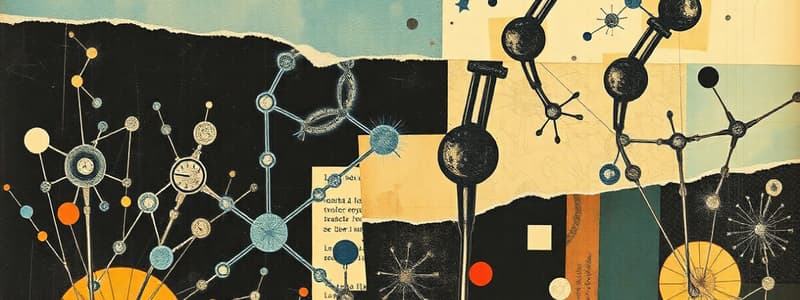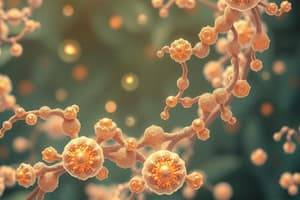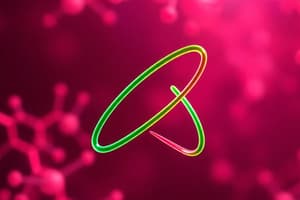Podcast
Questions and Answers
What is the primary purpose of cellular respiration?
What is the primary purpose of cellular respiration?
- To facilitate oxygen intake for the body
- To create new proteins from amino acids
- To break down glucose to produce energy in the form of ATP (correct)
- To convert glucose into DNA
Which level of protein structure refers to the overall three-dimensional shape formed by the interactions of various subunits?
Which level of protein structure refers to the overall three-dimensional shape formed by the interactions of various subunits?
- Quaternary structure (correct)
- Tertiary structure
- Primary structure
- Secondary structure
What is the primary role of RNA in cells?
What is the primary role of RNA in cells?
- To store genetic information
- To facilitate the translation of genetic information into proteins (correct)
- To create the double helix structure of DNA
- To catalyze biochemical reactions
What effect does denaturation have on proteins?
What effect does denaturation have on proteins?
Which technique is commonly used in medical diagnostics to detect specific biomolecules?
Which technique is commonly used in medical diagnostics to detect specific biomolecules?
What are carbohydrates primarily used for in living organisms?
What are carbohydrates primarily used for in living organisms?
Which biomolecule is responsible for carrying genetic information?
Which biomolecule is responsible for carrying genetic information?
What is the process called that synthesizes complex molecules from simpler ones?
What is the process called that synthesizes complex molecules from simpler ones?
Which factor does NOT affect enzyme activity?
Which factor does NOT affect enzyme activity?
What is the primary energy currency of cells?
What is the primary energy currency of cells?
What type of biomolecule is primarily involved in catalyzing chemical reactions in cells?
What type of biomolecule is primarily involved in catalyzing chemical reactions in cells?
Which of the following processes is an example of catabolism?
Which of the following processes is an example of catabolism?
Which term describes the breakdown of complex molecules into simpler ones?
Which term describes the breakdown of complex molecules into simpler ones?
Flashcards
Cellular Respiration
Cellular Respiration
The process by which cells break down glucose to produce energy in the form of ATP. It involves several stages like glycolysis, the Krebs cycle, and the electron transport chain.
Protein Structure and Function
Protein Structure and Function
The structure of a protein determines its function. Different levels of structure (primary, secondary, tertiary, and quaternary) dictate its shape.
Protein Folding
Protein Folding
The process by which a protein folds into its three-dimensional shape, essential for its function.
Protein Denaturation
Protein Denaturation
Signup and view all the flashcards
DNA Replication
DNA Replication
Signup and view all the flashcards
What is Biochemistry?
What is Biochemistry?
Signup and view all the flashcards
What are carbohydrates?
What are carbohydrates?
Signup and view all the flashcards
What are lipids?
What are lipids?
Signup and view all the flashcards
What are proteins?
What are proteins?
Signup and view all the flashcards
What are nucleic acids?
What are nucleic acids?
Signup and view all the flashcards
What is catabolism?
What is catabolism?
Signup and view all the flashcards
What is anabolism?
What is anabolism?
Signup and view all the flashcards
What are enzymes?
What are enzymes?
Signup and view all the flashcards
Study Notes
Introduction to Biochemistry
- Biochemistry is the study of chemical processes within and relating to living organisms.
- It encompasses a wide range of topics, including the structure and function of biomolecules, metabolism, and the regulation of biochemical reactions.
- This field overlaps significantly with other disciplines such as biology, chemistry, and medicine.
- Studying biochemistry helps us understand life processes at a molecular level.
Key Biomolecules
- Carbohydrates:
- Composed of carbon, hydrogen, and oxygen.
- Primary source of energy for cells.
- Include monosaccharides (simple sugars), disaccharides (double sugars), and polysaccharides (complex carbohydrates).
- Examples include glucose, fructose, sucrose, and starch.
- Lipids:
- Diverse group of hydrophobic molecules.
- Important for energy storage, cell membrane structure, and hormone production.
- Include triglycerides, phospholipids, and steroids.
- Examples include fats, oils, and cholesterol.
- Proteins:
- Chains of amino acids.
- Essential for various cellular functions like catalysis, transport, and structural support.
- Different levels of protein structure (primary, secondary, tertiary, and quaternary).
- Examples include enzymes, antibodies, and hormones.
- Nucleic Acids:
- Deoxyribonucleic acid (DNA) and ribonucleic acid (RNA).
- Carry genetic information, essential for protein synthesis.
- Composed of nucleotides.
- DNA stores genetic information, while RNA plays a role in protein synthesis and other cellular processes.
Metabolism
- Catabolism:
- Breakdown of complex molecules into simpler ones, releasing energy.
- Processes like glycolysis and cellular respiration are catabolic.
- Anabolism:
- Synthesis of complex molecules from simpler ones, requiring energy.
- Processes like photosynthesis and protein synthesis are anabolic.
- Energy Transformation:
- Cells capture and utilize energy from chemical reactions.
- ATP (adenosine triphosphate) is the primary energy currency of cells.
Enzyme Kinetics
- Enzymes are biological catalysts that speed up biochemical reactions.
- They act by lowering the activation energy needed for a reaction to occur.
- Key factors affecting enzyme activity include temperature, pH, substrate concentration, and enzyme concentration.
- Michaelis-Menten kinetics describes the relationship between enzyme activity and substrate concentration.
- The concept of enzyme inhibition helps understand how reactions can be controlled.
Cellular Respiration
- Cellular respiration is the process by which cells break down glucose to produce energy in the form of ATP.
- It occurs in several stages including glycolysis, the Krebs cycle, and the electron transport chain.
- This process produces a significant amount of ATP, essential for cellular function.
- Aerobic respiration requires oxygen, while anaerobic respiration does not.
Protein Structure and Function
- The structure of a protein directly dictates its function.
- Different levels of protein structure (primary, secondary, tertiary, and quaternary) determine the protein's shape and hence its role in the cell.
- Protein folding is a crucial process determining the 3-dimensional structure of a protein.
- Denaturation (loss of structure) disrupts protein function.
Nucleic Acid Structure and Function
- DNA carries genetic information in a double helix structure.
- RNA has various forms with different functions in protein synthesis.
- DNA replication ensures accurate transmission of genetic information through generations of cells.
- Transcription and translation convert genetic information into proteins.
Biochemical Techniques
- Various techniques are used to study biomolecules and their interactions.
- Chromatography, electrophoresis, and spectroscopy are common methods for separating and analyzing biomolecules.
- Techniques like ELISA are used in medical diagnostics.
- These techniques provide insights into the structure and function of biological molecules and cells.
Studying That Suits You
Use AI to generate personalized quizzes and flashcards to suit your learning preferences.




